

June 2015
Dark Globular Cluster
A mysterious new class of globular cluster has been found by ESO's Very Large Telescope in Chile. Found in the galaxy Centaurus A, these clusters look like normal clusters but contain much more mass. They are being referred to as "dark" globular clusters because they may either contain unexpected amounts of dark matter, or contain massive black holes. Neither scenario was expected nor is understood.
A team of scientists have studied 125 globular clusters in Centaurus A, a giant spiral galaxy that may contain over 2000 globular clusters, many of which are brighter and more massive than any found in the Milky Way. In comparison, the Milky Way contains around 150 globular clusters.
A globular cluster is a group of thousands of stars closely packed together. They are old stars that usually formed at the time the galaxy formed.
Using the FLAMES instrument on the Very Large Telescope, the scientists computed the mass of the clusters and compared the results to the how brightly each cluster shined. For most of the clusters, the brightness and mass were in sync with clusters containing more stars being brighter and having more mass. But some of the clusters has much more mass than their brightness indicated they should have. Digging deeper, the team discovered that the more massive these strange clusters were, the greater fraction of their material was dark. There was definitely something in the these clusters that was dark, hidden and massive.
Black holes could be the answer but the team concluded that it cannot be the entire cause. Dark matter is a possibility, but that goes against what we currently believe. It is believed that globular clusters do not contain dark matter. The team is now going to survey globular clusters in other galaxies to see if they can find more of these mysterious "dark" clusters. In the meantime, we know that we have much to learn about globular clusters in the Universe.
Sponge-like Hyperion
The Cassini spacecraft has made its last pass of Saturn's moon Hyperion. Hyperion is one of the most bizarre objects in the solar system. It has a sponge-like appearance.
Cassini flew by Hyperion on May 31 at a distance of 21,000 miles (34,000 km). Cassini's closest fly-by of Hyperion occurred on Sept. 26, 2005 when it flew only 314 miles (505 km) from the moon.
Hyperion is irregular in shape, almost resembling a potato. The surface appears to look like a sponge. Hyperion has an unusually low density. The density is about half of that of water. This indicates that Hyperion is quite porous with a weak gravity. Due to the low density, when objects like meteorites hit the surface, they do not dig in as on other bodies but instead compress the surface. This gives the sponge-like appearance. Due to the weak gravity, any material thrown up from the impact would not fall back to the surface but continue to fly out into space.
This is the last visit to Hyperion for Cassini. Cassini is currently on a path to revisit many of Saturn's moons before beginning the last part of its incredible mission, repeatedly diving through the space between Saturn's rings in 2017.
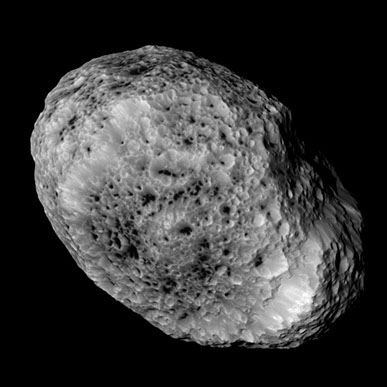
Credit: NASA/JPL-CalTech/Space Science Institute
Bright Spots on Ceres
As NASA's Dawn spacecraft neared the dwarf planet Ceres, it photographed a pair of mysterious bright spots. Dawn is now in orbit around Ceres and from a distance of 4,400 miles (7,200 km), the bright spots continue to remain a mystery.
Scientists have concluded that the brightness is caused by reflection of sunlight off of something highly reflective. One possibility, and the leading candidate currently, is ice. Another idea is that it is an exposed area of mineral or rock, perhaps a salt deposit.
Dawn is now moving to an orbit of only 2,700 miles (4,400 km) above the surface where it will remain until June 30th. At that time Dawn will move to an even lower orbit. Scientists will continue to photograph and study these mysterious bright spots.
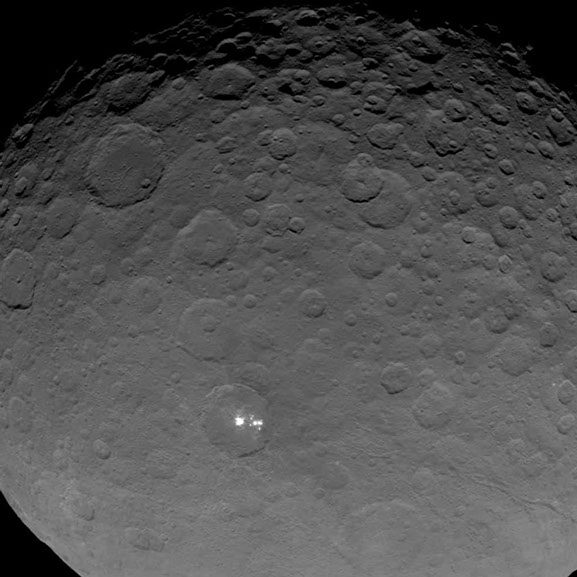
Credit: NASA/JPL-CalTech/UCLA/MPS/DLR/IDA
Upcoming Launches
Date: June 26
Launch Vehicle: Space-X Falcon
Launch Site: Cape Canaveral, FL
Description: Resupply mission to International Space Station
New Discovery by Rosetta
NASA's Alice instrument on board ESA's Rosetta spacecraft has made a starling discovery. Rosetta is currently orbiting within 100 miles (160 km) of comet 67P/Churyumov-Gerasimenko. As the comet moves closer to the sun, more activity on the comet is taking place with jets of water and carbon dioxide spewing off.
The Alice instrument can observe in the far-ultraviolet wavelengths. This allows scientists to study the chemical composition of gases. It was discovered that electrons close to the surface of the comet are responsible for the breakup of water and carbon dioxide, not photons from the sun as we previously believed.
Scientists would never have been able to make this discovery without going to the comet. Because of the Earth's atmosphere, ground based instruments could make these measurements.
As 67P moves closer to the sun, the comet will become even more active, blowing off plumes of water and carbon dioxide. It is believed that comets can hold the key to how the early solar system formed and what role comets played in providing water to Earth, the building blocks of life.
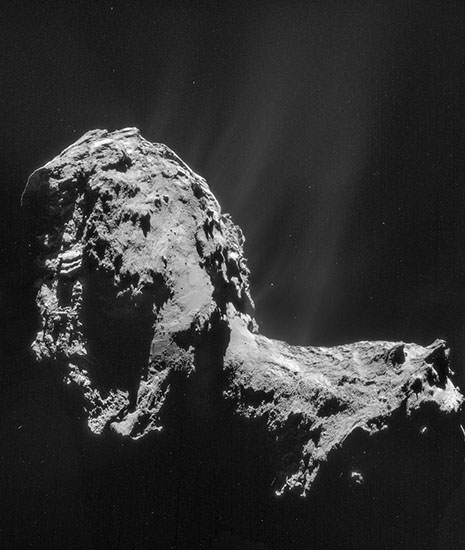
Plumes of water and carbon dioxide are shot off the surface of comet 67P/Churyumov-Gerasimenko.
Credit: ESA/Rosetta/NAVCAM
Shock Collision Inside Black Hole Jet
Over the past 20 years, Hubble has been observing the elliptical galaxy NGC 3862. It is one of the few active galaxies with jets from a black hole that can be seen in visible light. Most of the jets are only detected in non-visible wavelengths such as X-ray and Gamma ray. By comparing Hubble photos taken over the years, a collision between two hight speed knots of ejected material was observed.
When an object encounters a black hole, some matter is ejected back into space. As the object falls into the black hole, the material is superheated and ejected along the object's spin axis. One theory says that powerful magnetic fields form the material into a narrow jet. But if the material is not smooth, the ejected material will form blobs or knots and be shot out into space like a series of cannon balls fired one after another.
Hubble's photos revealed knots shot off after others have a faster speed and eventually catch up to the previous knot and rear-end it causing a shock collision. Why does the second knot move at a faster speed? One explanation is that perhaps the first knot cleared out the space and the second knot had less drag since it was traveling through "cleaner" space.
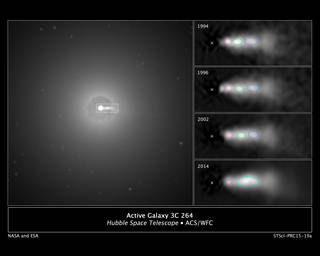
Knots ejected out of the black hole in galaxy NGC 3862 can be seen on the right side of this photo. The photos were taken over a 20 year period. The different knots were colored red, green and blue artificially so we can see them easier. The photos clearly show the "green" knot catching up to and impacting the "blue" knot.
Credit: NASA/ESA/E. Meyer (STScI)
Pluto's Tumbling Moons
As New Horizons gets closer to Pluto, the Hubble Space Telescope has been looking at the planet and its moons in advance of the spacecraft's arrival. New data shows that two of Pluto's moons, Nix and Hydra, wobble unpredictably. If you were on one of the moons, you would never know when or from what direction the sun would rise or set, nor when you would see Pluto or not. The moons just wobble about in any old direction that cannot be plotter nor predicted. They are shaped like a football or rugby ball.
The most likely cause is the gravitational field shifts constantly. This is because Pluto is really a double planet system. Charon and Pluto orbit each other from one central point between them. If you were on one side of Pluto you would always see Charon, if you were on on the other side of Pluto you would never see Charon. Charon is about half the size of Pluto.
It is likely that Pluto's other moons, Kerberos and Styx act the same way as Nix and Hydra. An interesting fact about Kerberos is that it is dark, described as the color of charcoal. The other moons are bright and sandy colored. The reason for this is unknown.
New Horizons will fly by the Pluto system next month. Hubble has given us tantalizing taste of what we will find there.
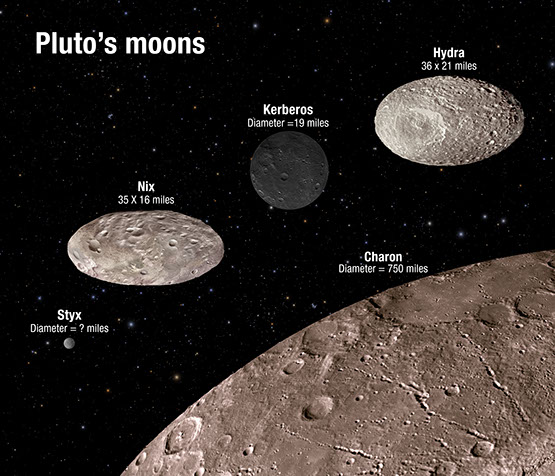
Artist concept. This illustration shows the size comparison of Pluto's moons and their apparent shapes and color. The surface detail (craters and such) is fictitious (we have to wait until New Horizons gets closer to let us see what they really look like). Credit: NASA/ESA/A. Feild (STScI0
© 2014-2016 Ted Cook Productions LLC. - All Rights Reserved

